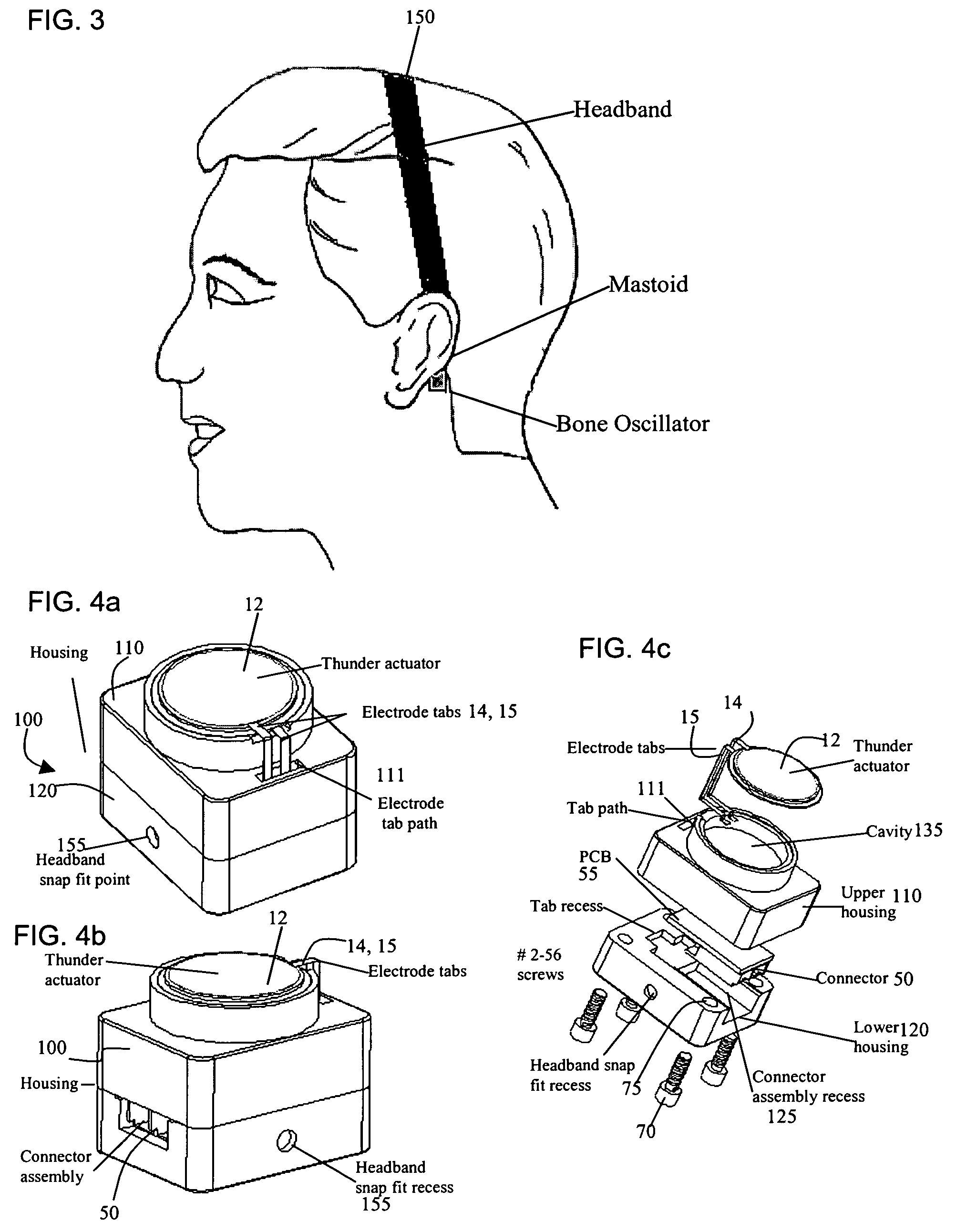Bone-conduction hearing-aid transducer having improved frequency response
a transducer and bone conduction technology, applied in the field of assisting in the perception of sound, can solve the problems of inability to use beyond 4 khz, inability to accurately detect the sound, and inability to conduct air conducted noise, etc., and achieve the effect of eliminating soldering wires
- Summary
- Abstract
- Description
- Claims
- Application Information
AI Technical Summary
Benefits of technology
Problems solved by technology
Method used
Image
Examples
first embodiment
[0112]Housing 1 (31 g brass housing). FIG. 11 show the force variation with frequency at input voltage levels of 2 and 10 Vrms respectively. 8C6S_epoxy signifies that the Thunder 1 was attached to the brass housing 100 at four diametrically opposite points (90° apart) with epoxy 80. As expected, the increase in the applied voltage shows a distinctive increase in the force level at each frequency. The actuators 12 show a well-defined response in the range of 250 Hz to over 8 kHz (only plotted up to 8 kHz). The force level at 100 Hz was low and the reading was not accurate at that frequency point. The response of the Radioear B-71 at 0.1 Vrms is also shown in each of the figures to emphasize on the dramatic performance improvement with Thunder technology.
[0113]For all the voltage levels, it is seen that the various bone vibration transducers 1 made with different Thunder actuators 12 thickness show very similar response. However, the transducer TH-8C6S shows a slightly better performa...
second embodiment
[0115]Housing 2 (51 g brass housing). FIG. 13 shows the force vs. frequency behavior of the Thunder Bone Conduction transducers 1 with 51 g brass housing at 2 and 10 Vrms input voltage level. The response is very similar to the ones with 31 g housing except that the low frequency response is improved. However, the dip in the range 5-8 kHz is larger which is not desirable. Further, the overall fluctuation in the force response is seen to be the highest in the TH-8C6S transducer which was considered to be best when used with 31 g mass.
[0116]Table 5 shows the performance of TH-8C6S Bone Conduction transducer 1 when used with 51 g brass housing 100. The ANSI S3.43 (1992) specifications and the values desired by HCRI are also depicted in the table. FIG. 9 shows the different force response curves for the TH-8C6S transducer for the applied voltage levels.
[0117]
TABLE 5TH-8C6S Bone Conduction transducer with 51 g brass housing.Force (dB: ref 1 dyne)Measured at Face at voltage inputsFrequenc...
third embodiment
[0118]Housing 3 (21 g aluminum housing). The test results with the two brass housings showed that increasing the mass of the system improved the frequency response of the transducer in the lower frequency range as a second order system would do. The interest then shifted towards making the system comparable in mass to the Radioear B-71 and see if there would be a drastic loss of performance in the lower frequency region. FIG. 15 shows the performance of a selected few Thunders when used with the 21 g aluminum housing. The Radioear B-71 performance at an input voltage of 0.1 Vrms included in the plots.
[0119]FIG. 16 shows the frequency response of TH-10C10S Bone Conduction transducer at 2, 10 and 20 Vrms with the 21 g aluminum housing obtained from the data of Table 6.
[0120]
TABLE 6TH-10C10S Bone Conduction transducer with 21 g aluminum housing.Force (dB: ref 1 dyne)Measured at Face at voltage inputsFrequencyANSI S3.43ofHCRI(Hz)(1992)2 Vrms10 Vrms20 VrmsSpecs.100—35.044.251.0—25072.051...
PUM
| Property | Measurement | Unit |
|---|---|---|
| frequency | aaaaa | aaaaa |
| frequency | aaaaa | aaaaa |
| force | aaaaa | aaaaa |
Abstract
Description
Claims
Application Information
 Login to View More
Login to View More - R&D
- Intellectual Property
- Life Sciences
- Materials
- Tech Scout
- Unparalleled Data Quality
- Higher Quality Content
- 60% Fewer Hallucinations
Browse by: Latest US Patents, China's latest patents, Technical Efficacy Thesaurus, Application Domain, Technology Topic, Popular Technical Reports.
© 2025 PatSnap. All rights reserved.Legal|Privacy policy|Modern Slavery Act Transparency Statement|Sitemap|About US| Contact US: help@patsnap.com



